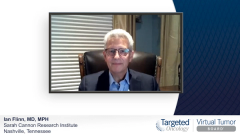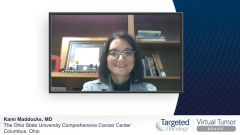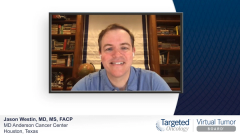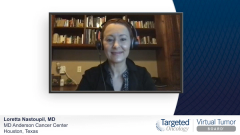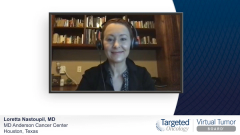
Case 1: Trials in CAR T-Cell for Patients With Relapsed/Refractory DLBCL
Loretta Nastoupil, MD: ZUMA-1 [NCT02348216] was the pivotal phase 2 study that led to FDA approval of Axi-cel, or axicabtagene ciloleucel, based off this study design. What’s unique about this trial … is that it primarily enrolled refractory patients with diffuse large B-cell lymphoma [DLBCL], primary mediastinal, or transformed follicular.
They reported out two different cohorts, cohort 1 with refractory large cell, and cohort 2 with the refractory primary mediastinal and transformed follicular. There’s some notion that the patients with primary mediastinal transformed follicular do slightly better. … This is a relatively small sample size of 101 patients. The dosing and conditioning regimen is unique to this study and that patients received 500 mg/m2 of cyclophosphamide, and 30 mg/m2 of fludarabine for 3 consecutive days starting day -5. They received a flat dose of 2× into 6 cards/kg.
And the other important thing about this study is that there was a high successful manufacturing in administration of these cells, and 99% of patients who were enrolled had successful manufactured product, 91% were dosed.
This is the updated analysis with a median follow-up of 27.1 months, and you can see the median progression-free survival had not changed, it remained at approximately 6 months. But the median overall survival at this time point had still not been reached. It settled out with 3 years of follow-up right around the 26-to-27-month period. … This was a significant improvement in the survival for these patients that were, again, facing dismal outcomes.
In contrast, this is a JULIET study [NCT02445248] that is, again, a single-arm phase 2 study that was the pivotal trial that led to FDA approval of tisagenlecleucel.
This was different in terms of study design and conduct, so this is a large international multicenter study. There was a lapse in time from screening and enrollment until infusion of cells, which primarily just dealt with the fact that they were trying to get this therapy out to a much larger patient population. And as a result, bridging was allowed because of that time delay from enrollment and to infusion itself.
There’s also a difference in the lymphocyte-depleting chemotherapy that was administered in this cycle. And as a result, there were fewer patients that received cell infusion in comparison to the ZUMA-1 study. However, for the patients who achieved a complete response, that was quite durable. And you could see here, as outlined by this progression-free-survival, it’s much better for patients who achieved a complete response versus all patients. At 12 months, our relapse-free survival was 65%, and the median overall survival was about 12 months. That does take into consideration there was a higher proportion of patients who never made it to cell infusion as a result of the difference in this study design.
Though it’s hard to compare the efficacy across these studies because the patient populations were clearly different, the conduct of the studies were different. The most important thing to recognize is this is an effective strategy, and that you see higher complete response rates than we’d ever seen in third-line large-cell lymphoma, and much higher overall survival than we had seen to date.
In addition, the toxicity is hard to compare across these studies because different grading systems were applied. However, there are some notable differences, and that has to do with the construct. Axi-cel is a CD28 costimulatory CAR, which leads to more rapid T-cell expansion, which is mediated and driven by cytokine production, and as a result we do see shorter time to onset of cytokine release syndrome [CRS]. If we’re applying the same grading criteria, you see slightly higher rates of grade 3 or higher CRS, and particularly higher rates of neurotoxicity.
Liso-cel, which is a 41BB construct in the third that’s anticipated to be FDA approved, may have the most favorable toxicity profile, but I think that’s also the evolution of our ability to recognize and mitigate some of these toxicities, which is why you see much lower rates of grade 3 or higher CRS in neurotoxicity. Comparably, the 41BB constructs are just safer, particularly about neurotoxicities in the CD28 construct.
Transcript edited for clarity.



